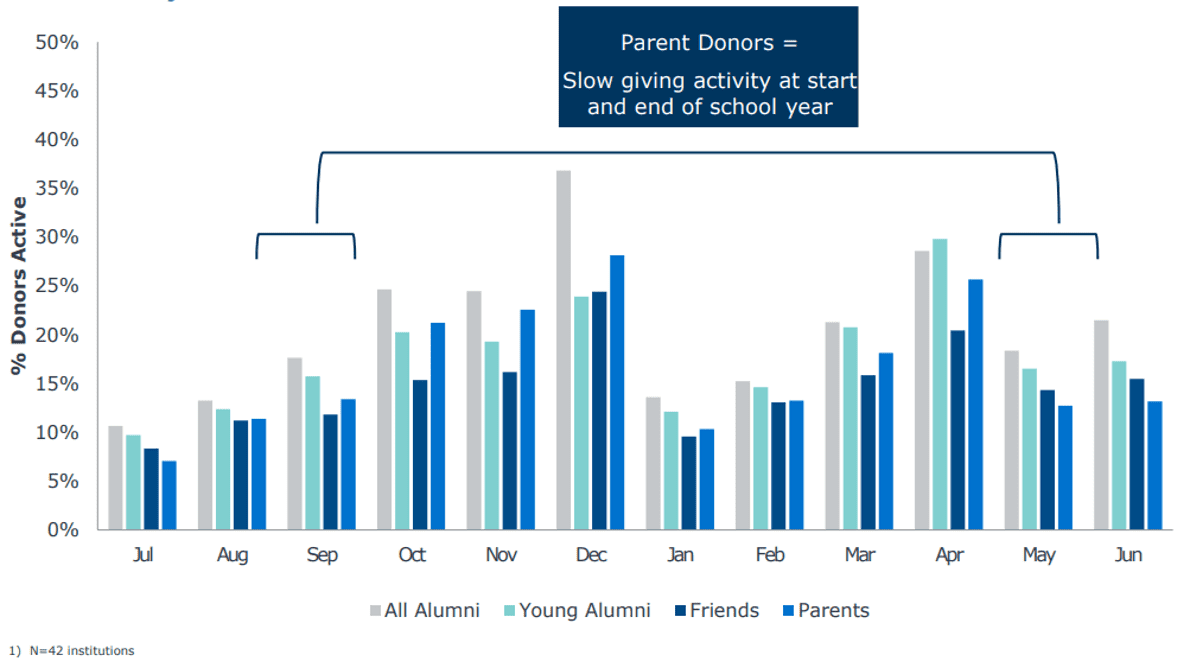The power of a diverse donor portfolio in your annual giving program
Today’s advancement leaders will need to access the untapped potential of key audiences beyond alumni stakeholders if they’re going to meet their constantly growing institutional goals.
The good news is parents of alumni, community members, and the dedicated faculty and staff at your institution all represent promising contributors. To effectively engage these segments, it’s essential to understand their behaviors, aspirations, and motivations. In this blog, we’ll explore these often-overlooked audiences and dive into why and how you should incorporate them into your annual giving program.
-
Why engage non-alumni audiences?
While alumni remain vital to the success of an annual giving program, their behavior can be unpredictable, and recent years have witnessed a steady decline in alumni engagement. Diversifying your donor base is essential to ensuring a more stable stream of support. It’s no longer prudent to rely solely on alumni; institutions must actively engage non-alumni audiences to bridge the revenue gap left by disengaged alumni.
-
43%
of alumni are not connected to their alma mater at all.
-
42%
of alumni define themselves as impulse givers.
Three key audiences to engage in your annual giving program
1. Parents of alumni
Parents of alumni represent a highly motivated and invested audience in your institution’s success. EAB enrollment research has shown that they have become increasingly involved in their children’s college experiences, forming a deep personal connection with your institution. This connection and pride in their child’s alma mater make them promising candidates as donors to your institution.
Timing is a crucial aspect of the donor journey. Start building connections with parents as early as you can. Their perception of your institution begins the moment they step on campus during initial visits. You should initiate communication and involvement at this stage, offering non-monetary engagement opportunities to begin to foster a lasting relationship.
-
Timing is key
EAB research indicates that parents are more likely to donate at the end of the calendar year for tax benefits and within five years of their child’s graduation.

Additionally, by leveraging the enrollment data available at your institution to understand their motivating factors and preferences, you can tailor your messages more effectively. Whether it’s a desire to support an academic department, contribute to athletic programs, or be part of creating an inclusive community, tailoring your messages around their interests can keep them more engaged and eager to donate.
-
Understanding the right channels for the right audiences
EAB research shows that parents have indicated a higher interest in receiving direct mail pieces compared to many other audience segments.
2. Community Members
Don’t underestimate the potential of engaging community members in your annual giving strategy. With over 2/3 of US adults inclined to support charitable causes, your local community can become a powerful force behind your institution’s mission.
-
69%
of U.S. adult citizens say they donate money to charitable causes or organizations.
Community members often gravitate towards causes that align with their identity or values. Crafting campaigns that focus on a specific identity embraced or supported by your institution can resonate deeply with these individuals. For instance, annual giving campaigns customized to various religious or faith-based communities, race/ethnicity groups, first-generation students, and low-income individuals can further enhance engagement and donations with community members who share or identify with these values and affiliations.
In addition to identity and values, community members resonate with the tangible advantages of a thriving institution within their local area. Whether it’s improved local amenities, access to a skilled workforce, or cultural enrichment, the direct benefits of a thriving institution can be substantial. In your engagement efforts, emphasize how their financial contributions will directly benefit them and their surroundings. Showcase initiatives that directly impact the local community, such as a Performing Arts Center that enhances cultural experiences, a Visiting Professor Lecture Series that enriches intellectual discourse, investments in athletics teams and facilities that foster community pride, or expanded library and tech resources that offer valuable educational opportunities. By demonstrating the tangible and positive effects of their support, you can motivate community members to become enthusiastic donors to your institution.
-
Watch our webinar for more insights
Join the conversation between myself and Mark Shreve, Senior Director of Partner Development, about activating these non-alumni audiences. Watch our on-demand webinar and explore effective strategies to expand your annual giving program.
3. Faculty and Staff
Through teaching, research, administration, and student support, faculty and staff members possess an intimate understanding of your institution’s mission. This makes them prime potential donors. However, engaging this internal audience requires a thoughtful approach that takes into account their specific sensitivities.
Simplicity, flexibility, and transparency are paramount with this audience. Offer a range of giving options, including one-time gifts, payroll deductions, and opportunities to support specific departments or initiatives that resonate with them personally. Incentivize faculty and staff contributions through recognition programs, exclusive merchandise, and staff benefits, demonstrating your appreciation for their commitment.
Additionally, it’s essential to understand the overall atmosphere and morale within the institution. Are there ongoing challenges or concerns that might affect faculty and staff’s willingness to engage in giving? This awareness will guide you in determining the right time and approach to engage faculty and staff, leading you to a positive culture of giving within your institution’s internal community. When done right, faculty and staff can become enthusiastic advocates and invaluable supporters of your annual giving initiatives.
-
Note:
Faculty and staff can be key donors to your annual giving program. But many institutions aren’t engaging this audience.
-
32%
of institutions do not run a faculty/staff giving campaign.
-
70.9%
average retention rate for faculty and staff donors for EAB partners.
Strengthening your financial foundation
Broadening your horizons to include non-alumni audiences can be a game-changing strategy. The three audiences outlined here bring unique opportunities and potential to your institution’s annual giving program. Understanding their motivations and crafting tailored strategies can open doors to increased support and engagement, ultimately strengthening your financial foundation and fostering a deeper sense of community.

More Blogs

3 strategies to modernize your advancement approach in 2026

How affluent women are redefining philanthropy
